Site index
About
Dance calendar
Dance courses
Noticeboard
Dance reports
Techniques
Improvisation
Schottishe
Hambo
Waltz
Snoa & Polka
Mazurka
Polskor
Modern Dance
Other
Links
..Courses
..Festivals
..Other
History
Blog
Outdoors
..Reports
..Walk Guide
..Mountain walks
Dogs
..Lava
Preferences
Login
Contact
Modern social dances - instructions with examples
- Contents: Foxtrot, bugg, jive, lindy hop, balboa, boogie woogie, salsa, tango
- Description
Dance Instruction: Modern social dances - instructions with examples
Target Audience: Beginners and intermediate dancers - Author: Örjan Wikström
- Genre: Dance - Social dancing to modern dance music
Contents
- Foxtrot
- Foxtrot basics
- Variations
- Bugg
- Swing - jive, lindy hop, boogie woogie
- Our swing mix
- Balboa
- Tap dance
- Salsa
- Tango
- Swedish Tango
- Finnish Tango
- Argentinean Tango
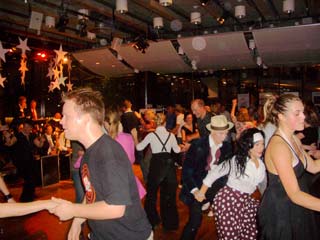
Foxtrot
When I started to visit public dances and especially the GDV dance events, I came early in contact with foxtrot and other modern dances. If you want to learn just one dance, I believe foxtrot is the best choice. I feel that foxtrot should be included in the all-round education, and that consequently the dance should be taught at the intermediate stage of the compulsory school.
The description below refers to the common foxtrot, and should not be mistaken for the slow foxtrot. Slow foxtrot is one of the most demanding competition dances, and has a style and steps that, despite the name, is more agile than the common foxtrot.
Foxtrot basics
The music in foxtrot uses a 4/4 tempo. The steps are in the rhythm slow, slow, quick, quick, where the slow steps use two beats and the quick steps one. This means that one step sequence use one and a half bar. For this reason it does not matter if the dance is started when the bar begins or in the middle of it.
The basic step is directed in a 45 degrees angle towards the dancing direction. At the quick steps the couple turns 90 degrees and take the next steps in the other direction (backwards if starting forwards).
If the leader starts forwards and the follower backwards, the couple then moves aslant forwards and outwards. The leader starts forwards on his left foot with a slow step, the follower starts backwards on her right. At the quick steps the couple turns roughly 90 degrees clockwise, and then the leader starts the slow step backwards on his left foot, the follower steps forwards on her right foot. The couple then dance diagonally inwards until the next quick steps, when the couple turns about 90 degrees counter-clockwise and starts to dance diagonally outwards again.
The couple will thus move in a small zigzag pattern counter-clockwise along the dancing floor.
The basic dance usually also includes turns clockwise and counter-clockwise, as illustrated in the video below.
Variations
Foxtrot is a dance that is easy to vary. Although the basic step is slow, slow, quick, quick, it works just as well to take steps on each beat.
It is also easy to go back to the basic steps as it can be done both at the beginning of and the middle of each bar.
This can be used to express the music in the dance.
Many variations are transferable between gammaldans as schottische and polka, foxtrot and bugg, and also in some cases tango. Thus some variations described for other dances also are used in this dance.
The attached video shows how we use to dance foxtrot.
Bugg
When I began to dance, I did so by first go thorugh a dance class, and then once a week visiting GDV dances - At these dances. besides gammaldans, also foxtrot and a limited lot of tango, modern waltz and latin were played.
When foxtrot was played, same as today also bugg was danced. But I had at that time not visited any dance class for bugg, but rather just imitated other dancers.
At that time the bugg dancing was not always well seen, because the dance floor was almost always crowded, which required dancers to follow the flow on the dance floor and use as little space as possible. So bugg dancers were advised to stay in the middle of the dance floor, and also for some time were only allowed to dance bugg in every other modern dance.
So the bugg dance I met then was mainly danced without much movement around the dance floor. The steps I imitated were based on that, and - as I remember it now - may be that was also the case in the first bugg dance classes I later visisted. That was changed when I again joined a few bugg classes, the basic steps were then changed so bugg dancers moved around the dance floor.
Despite these later classes, I am not sure if I still mix my initial bug dance with the bug dance I later learned. For that reason, I refrain from describe the bug dance here, and recommend instead those interested to participate in a dance class.
Swing - jive, lindy hop, boogie woogie
Swing is not just one dance, in this context it is used as a joint expression for jive, Lindy Hop (jitterbug) and Boogie Woogie.
The first of these three dances we came in touch with was jive. We participated in a series of classes at Mälarsalen, ending in 1992.
We feel that rock'n roll music from the 50's at a high pace does the jive dance most justice - the fitness might be stretched.
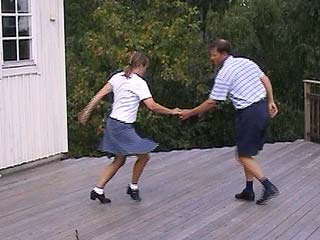
Later we participated in a succession of Lindy Hop classes at Swedish Swing Society. When we joined those in the spring 1998, the dance was often called jitterbug. It was at that time we started to use the term swing. The reason was that although Lindy has a slightly different style compared with jive, we felt that it is more that unites than differentiates these dances.
As an example, the most common basic step - chasse step left (left quick, right quick, left slow) with some syncopation chasse step right with syncopation, followed by backwards/forwards (slow/slow) - is used similarly in both the dances.
Also some of the variants we had earlier learned in jive were directly transferable and commonly used in Lindy Hop. But there were differences as well - in Lindy swing outs using eight beats are frequently used, while turns using six beats are perhaps slightly less frequent.
With our previous experiences, we thought that it was the other way around from what we had met in jive. Variants using six beats were common in jive while variants using eight beats (e.g. whip) were slightly less frequent.
The typical dance music also distinguished the dances - in Lindy mostly jazz music was used, with a widely spread tempo - both slow and rather rapid music was used. But again, the difference was not bigger than that we without problems could practise both the dances with the same music.
At SSS we also learned to vary the basic steps - the three chasse steps can e.g. be replaced by using just one or two steps. In the SSS Lindy classes we were encouraged to vary steps, sequences and variants.
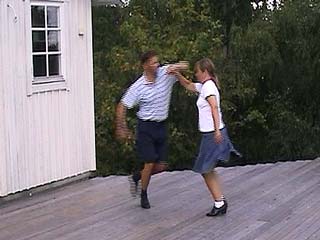
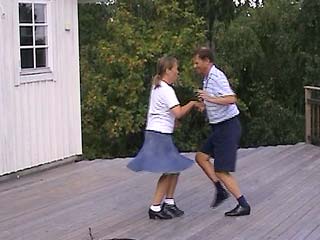
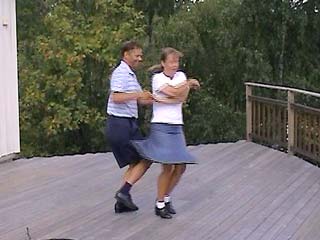
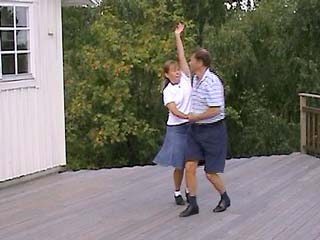
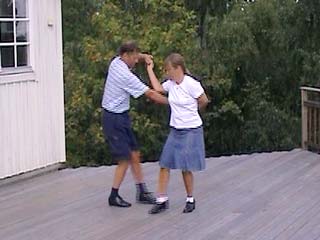
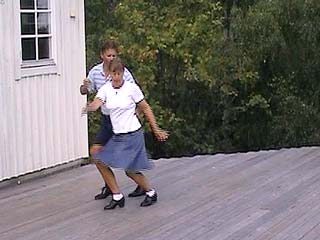
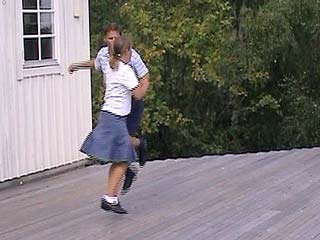
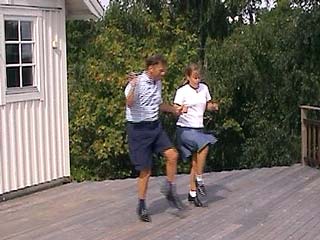


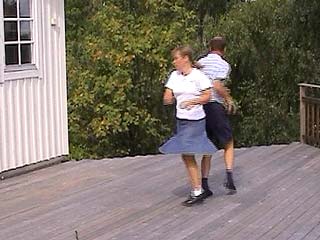
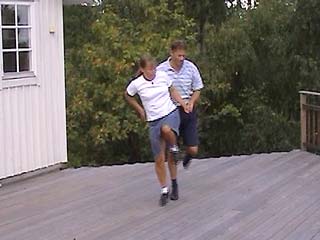
Boogie Woogie was the swing dance we last came in touch with. We joined a sequence of classes at Ebba Dansklubb, starting in the spring 2002. In these classes we had to reconsider most of what we earlier had learnt. Although the basic step also is used in Boogie Woogie, it is not executed in the same way.
Among what is left in our minds after these classes is to work on getting a proper "bounce", that backwards step instead mostly is headed forwards, that the leader makes way for the follower, that the couple should keep it's line all the time (e.g. after a swing out the couple should be headed in the same direction as before throughout the dance).
It is fascinating to watch good Boogie Woogie dancers, the masters of the basic steps are perhaps found in this dance. But for us, what we learned from Boogie Woogie has not made any heavy footprints in our dance.
Íf the reason for this is that we last came in touch with the dance, we can't say.
Despite that we felt that there are many differences between Boogie Woogie and the other swing dances, we still think that it is a lot that unites this dance with jive and Lindy. Many steps and variants are found in Boogie Woogie as well, although often exercised differently.
 Our swing mix
Our swing mix
When we dance swing we often differentiate which of the dances we dance, but in practise we mostly mix them. For this reason we feel that swing is the best term for our way to dance.
The video below shows how it might look when we dance socially to swing music. In this case the dance mainly contains jive variants. The reason was the length of the music. The music just contains a Boogie Woogie chord I put together to avoid using non free music, and unfortunately ends when we are in the process of changing to Lindy Hop.
Balboa
Balboa is another nice and amusing swing dance, that we unfortunately only at a few times have practised socially. For that reason the contents below is based just on recordings for our own memory, at home after the balboa dance classes we joined.
Imagine a crowded very slippery dance floor. Each couple has very limited space, but occasionally small spaces might occur that can be utilized or moved to for a dance variant requiring some more space.
The hold in the dance is tight, and the basic steps in the dance is shuffling, using same rhythm as in the schottishe. The video below contains some of what we learned from the classes.
As we have very limited experiences of dancing the balboa socially, we did never reach a level of improvisation and flow in the dance.
Tap dance
Tap dance is perhaps not associating to social dance by couples, but is anyway included here. Our most appreciated tap dancers - Fred Astaire and Ginger Rogers, have left behind unforgettable dance movies, illustrating that couples and tap dancing is indeed compatible.
We have participated in a few tap dance classes with different direction. My first experience was that the steps no longer were dependent of a dance partner, opening new exciting possibilites for dance steps.
Tap dance requires however much practising of the muscle motolities, but can also be really fun.
Primarily because we have always been focusing on social dancing in couples, the tap dance was just a sideline, that we did not continue to build on. But despite this, we have at least once danced a full cha-cha-cha in a couple with tap (chorgraphed) at a social dance event at Mässhallen (Mälarsalen).
Eventually, later a short video where Ellika is practising step with waltz beats at Tynningö will be included here (music pasted by me afterwards)
Salsa
Same as for the tap dance above and the tango below, we have despite that we have participated in several salsa classes, we have not included salsa events with those we must visit as soon as they arrive.
This might be caused by our music preferences, but more likely, that the social dance events with mixed contents with both modern music and the Swedish gammaldans and polskor that we prefer, rarely contains any salsa music.
As with other dances, there are several flavours of salsa. The style that we came to like best was the cuban salsa. Below is a video when we practice basic steps from the cuba salsa classes, and a similar video showing some variants when dancing together.
Tango
Tango is another of these dances I met in early days. We have then met it in many flavours - in dance classes, and at public social dance events.
These tangos include European tango (ballrom), Swedish, Finish and Argentinean tango. The Euoropean/ballrom variant was included in one of my very first dance classes, and is today totally forgotten for me. But I believe that was the style I tried to practice at my early GDV dances.
I met the other tango variants mentioned later in time, and will try to give a brief description of them.
Swedish Tango
The Swedish Tango is danced in a closed hold, stomage against stomage and toe against toe. All basic steps are taken beyond the other foot, forwards when dancing forwards, backwards when dancing backwards. The steps should flow smoothly over the dance floor, never tripping. As the toes in the couple are headed against each other but should never touch(Aoooh!), it might need some practising.
Except for the basic steps there are only five variants - saunter, right turn, left turn, habanera and quick turn ending with deep backwards leaning for follower. After the right/left turns the couple continues forwards on the floor but in opposite positions.
The variants can be altered slightly some times, e.g. the habanera can be combined with the left turn. All variants are performed with energy/schwung.
Finnish Tango
As we not very often have danced the Finnish tango socially, we do not remember it well.
From my memory however, the basic steps are more like in foxtrot, and just as with the Swedish tango there are just a few variants. For example, the habanera exists there as well, but is not performed in the same way. And the variant with the backleaning follower exists also, but performed slightly different and some times so deep that the follower almost touch the floor.
Argentinean Tango
The Argentinean Tango is if you ask me the thoroughbread tango. As with other dances I like best, it offers unlimited possibilities for variation and improvisation.
When saying this I must admit - I have never came close to what excellent tango dancers conveys with their dance. For me, I feel I am cheating with my attempts to perform the dance, but I still do that with joy.
And - as in any vernacular dance - I have already experienced that there is more than one way to perform also this dance.
At our first contact with this dance, we met a folksy variant, where the foxtrot basic steps could be recognised, however with a distinct tango character.
Even though we participated in Argentinean tango classes with other styles later, where the movement around the dance floor was not as prominent, the folksy variant we first met is the one we have taken to us.
As we always prefer dance events where all kinds of dances are mixed, there have not been many dances that could be categorized as tango evenings. The closest match, that we appreciated much, were the dances named `Omåttlig dans` (Excessive dance), where often Lindy Hop and Argentinean dance were mixed, but also occasionally Lindy Hop and Salsa. Unfortunately this was before the first digital camera was launched.
I have only found a very short video clip where we take a few tango steps 2002. That was at a very nice dance at Midsommargården, where we got a very nice evening with well mixed dances. That little clip might be included here later.
Swing at Nalen
Last updated: Jul 25, 2024